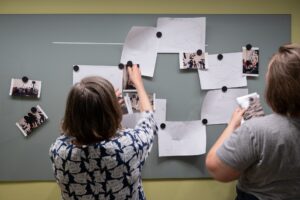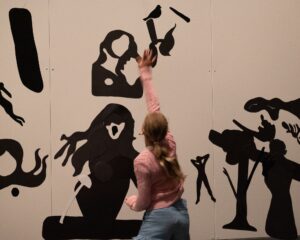New cultural spaces for independent practice-based research outside of Higher Education during shifting times.

In the concluding chapter of Spatial Relations: Dance in the Changing Museum my PhD thesis (2020, Centre for Dance Research, Coventry University) I made a call for a new role for dance research in the contemporary art museum. It was the start of the COVID pandemic in the United Kingdom (UK), and I imagined the potential of dance in the museum not only as an art form to present or as a technique for public engagement, but as an embodied social relational practice. This practice could interact with and respond to the museum during a time of change, helping to create more human-centred collective spaces for action. My thesis borrowed from Gabriella Giannachi’s (2011) theories on presence as modes of encounter, arguing for the dance artist as part of and affective to the human ecosystem of the museum.
I have worked in contemporary art museums independently as a dancer, choreographer, performer, advisor, and scholar across curation, learning, and research departments over the past twenty years. My interest was in what a practitioner researcher role might offer. Specifically, I considered how it could benefit those conducting research outside academia and contribute to the museum’s projects. I sought to expand opportunities for both the practice of dance and critical perspectives on its role and influence within cultural institutions. I asked: what would a practice-based research role in the museum provide in terms of space and resources for research into embodied knowledge and relational practices of dance? How might the museum benefit from such insights?
Fast forward to 2024, I was invited to become the first external practitioner researcher at the MUNCH in Oslo. For one year, I investigated and critically examined the collaborative research practices employed in the context of the MUNCH museum’s ‘Come Think with Us!’ (CTWU) series - a project designed to work collaboratively with artists and audiences. I was specifically invited to focus on Sofie’s Room, an interactive installation and intervention in the museum by choreographer Roza Moshtaghi and her sister, visual artist and performance maker Ronak Moshtaghi.
The practitioner researcher role was created by Birgitte Aga, Head of Research and Development at MUNCH. We framed the research around two central questions: first, it explored how the concept of ‘social choreography’[1] could be used as a conceptual framework to examine audience participation. Second, it investigated how adopting a collaborative, practice-based research approach could further enrich understanding of the dynamics at play in participatory museum settings.
The concept of social choreography offered a powerful lens through which to analyse Sofie’s Room. Rooted in the artists’ intentions, this approach transformed the act of engaging with materials - such as magnets, benches, and fountains - into a dynamic, collaborative performance. It shifted the focus from the artwork to the social and behavioural patterns emerging among visitors, highlighting how collaboration and spontaneous interactions redefined the space and the artwork. This process offered new perspectives, some not anticipated by the makers. In my findings, I wrote:
From my observations and research, I witnessed a space not, as such, ‘choreographing the audience’ [as suggested by the artists who created Sofie’s Room], but the other way around—the participants were shaping, co-creating, and co-choreographing place through their actions and movements. The objects (magnets, fountain, and benches) were the tools or props with which visitors engaged in this choreographing place. We might then look curiously at social choreography and ask from where the choreography is emerging. In this case, I speculate it is coming through the actions of the participants, rather than the hands of the artists. Yet, the artists of Sofie’s Room set the stage, provided the props, and made the invitation to co-choreograph place possible.
[1] The term ‘social choreography’ was coined by Andrew Hewitt, Professor of Germanic Languages and Comparative Literature at the University of California, Los Angeles, in his 2005 book, Social Choreography: Ideology as Performance in Dance and Everyday Movement. Hewitt asserts that social choreography is not merely a metaphor but a tangible practice that reveals underlying social relations and patterns, which he terms the "choreography of the social”, through embodied practices.

As a practitioner researcher in dance studies, focusing on a project created by a choreographer and performance artist in the museum felt closely aligned with my interests. It offered me the opportunity to apply a theoretical framework to questions of participation that was both new to me and led to new insights for my research and for the museum. This contributed to an expanded understanding of participatory programmes and audience engagement.
As part of this process, I engaged directly with the artists and collaborated with curation, learning, and research teams - most closely with Tove Aadland Sørvåg, Curator for the CTWU series and Concept Developer at MUNCH. These exchanges and sustained collaborations across the research year felt important to the project, especially as an external practitioner researcher invited into the institution. Advocating for collaborative research approaches in the museum felt essential to the ethos of practice-based research, though it may not have been familiar to those working in institutions like MUNCH, where roles often have clear boundaries. However, there was an openness to considering the value of practice-based research in the museum, both within learning and beyond the more expected spaces of curatorial research.
Overall, the opportunity to work over the course of a year - conducting three site visits to Oslo and working remotely on the project - was an exercise in exploring research within a new role in an innovative and forward-thinking institution. New roles are both exciting and hold the potential to open spaces for practice-based research within cultural institutions. They are also challenging in defining such a role, as there may be diverse agendas and the work often takes place over a limited period. What I learned was that a practice-based research role in a museum like MUNCH provides remunerated space and time for research, while also balancing the interests and needs of the museum, which seeks to benefit from the researcher’s insights. There can be the need to separate out research which develops new knowledge, decide who owns intellectual property and research that supports consultation. The latter would be engaging research already done and then applying it. My work with MUNCH took concept of social choreography as a theoretical lens whilst developing new insights of participatory programmes from a practitioner researcher perspective. It did not necessarily produce new knowledge, however, that would have required a discussion about authorship.
What was particularly positive about working with MUNCH was the openness to change and learning that I felt across the museum. Perhaps, as it was a new position for my research, there is also value in clarifying early on whether the research is meant to deliver new knowledge or to unpack and further elaborate on existing knowledge. The latter might align more closely with a consulting role than with research. I am still reflecting on my work with MUNCH and learning from it as I continue to work across academia and cultural institutions.
I remain hopeful about the potential of cultural institutions as spaces for practitioner researchers. For those from the independent sector, it may be a matter of defining that role with the museum early in the process. It is important to clarify whether the aim is to produce new research (and consider who holds the intellectual property) or to focus on reflection and reporting. I experienced elements of both during my role at MUNCH. Looking back, given the limited duration of the project, I reflect on how the focus might have benefited from being more clearly oriented towards either research or consultation.
Last spring, following my project with MUNCH, I participated in the MUNCH research seminar Participation as Practice. Prior to that event the open-source reflective piece I produced for the project was made publicly available. Through discussions with curators and learning experts from across the region, it became clear that the resource had been useful to them and had influenced their thinking around participatory programmes in their own museums.
The open-source reflective document produced from the research can be downloaded here.
…
Sara Wookey
Sara asks pressing questions about the nature of human interaction that finds articulation through public sector spaces. She works across cultural and academic sectors in the UK, US, EU and SE Asia exploring the ways in which dance participates in the evolving project of the museum. She was an Associate Researcher at Tate Modern and Tate Britain (2017-2018), curator of young people’s performance at Tate St Ives (2015) and an Associate Researcher at the University of New South Wales on the project Precarious Movements: Choreography & the Museum (2022-2024). Her practice research has been published by Valiz Press, Routledge, Art Review and has a forthcoming monologue with Bloomsbury due out in 2027. Her dance-based work Punt.Point is part of the permanent collection of Van Abbemuseum. She is currently an Affiliate Researcher at the Centre for Research in the Arts, Social Sciences and Humanities at the University of Cambridge and a Senior Post Doctoral Research Fellow at the University of Antwerp and based in the United Kingdom. Alongside Dr Anna Pakes, Sara co-founded the independent research in dance and performance (IRDP) network. For more information or to contact Sara at: www.sarawookey.com
Photos © Christian Kipp www.christiankipp.com
Image 1 caption: Sara Wookey, Practitioner Researcher and Tove Aadland Sørvåg, Curator for the CTWU series and Concept Developer at MUNCH
Image 2 caption: Participant engaging with the materials (magnets) as part of Sofie’s Room
References
Giannachi, G. and Kaye, N. (2011) Performing Presence: Between the Live and the Simulated. Manchester: Manchester University Press
Munchmuseet (2025) Moving together: practice-based research in Sophie’s room. Available at: https://www.munch.no/en/about/research-and-innovation/research-from-edvard-munch-to-the-present/moving-together-practice-based-research-in-sophies-room/ (Accessed: 25 October 2025).
Hewitt, A. (2005) Social Choreography: Ideology as Performance in Dance and Everyday Movement. Durham: Duke University Press
Pringle, E. (2019) Rethinking Research in the Art Museum. London: Routledge
Wookey, S. (2024) Exploring Collaborative Research and Participatory Practices in Museums. Oslo: MUNCH museum.
Wookey, S. (2023) Democratic organisational structures & the multitude in the choreography of Yvonne Rainer. Wookey Works. Available at: https://sarawookey.com/democratic-organisational-structures-the-multitude-in-the-choreography-of-yvonne-rainer/ (Accessed: 25 October 2025).
Wookey, S. (2023) Shifting positions, changing perspectives: human movement and design as change makers in the museum. Wookey Works. Available at: https://sarawookey.com/shifting-positions-changing-perspectives-human-movement-and-design-as-change-makers-in-the-museum/ (Accessed: 25 October 2025).
